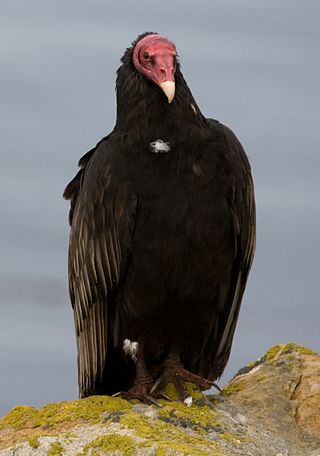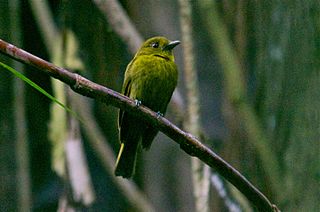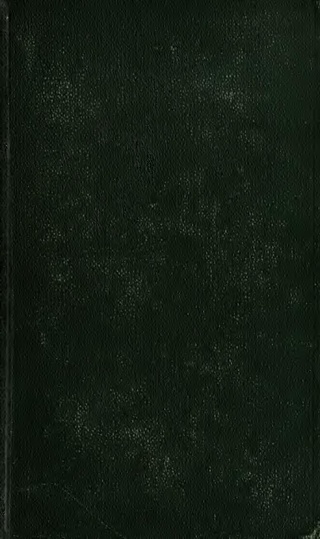Related Research Articles

Cathartidae, known commonly as New World vultures or condors, are a family of birds of prey consisting of seven extant species in five genera. It includes five extant vultures and two extant condors found in the Americas. They are known as "New World" vultures to distinguish them from Old World vultures, with which the Cathartidae does not form a single clade despite the two being similar in appearance and behavior as a result of convergent evolution.
The Sibley–Ahlquist taxonomy is a bird taxonomy proposed by Charles Sibley and Jon E. Ahlquist. It is based on DNA–DNA hybridization studies conducted in the late 1970s and throughout the 1980s.

The Old World flycatchers are a large family, the Muscicapidae, of small passerine birds restricted to the Old World, with the exception of several vagrants and two species, bluethroat and northern wheatear, found also in North America. These are mainly small arboreal insectivores, many of which, as the name implies, take their prey on the wing. The family is relatively large and includes 351 species, which are divided into 54 genera.

The hairy woodpecker is a medium-sized woodpecker that is found over a large area of North America. It is approximately 250 mm (9.8 in) in length with a 380 mm (15 in) wingspan. With an estimated population in 2020 of almost nine million individuals, the hairy woodpecker is listed by the IUCN as a species of least concern. Some nomenclature authorities, such as the eBird/Clements checklist, place this species in the genus Dryobates.

The American Ornithological Society (AOS) is an ornithological organization based in the United States. The society was formed in October 2016 by the merger of the American Ornithologists' Union (AOU) and the Cooper Ornithological Society. Its members are primarily professional ornithologists, although membership is open to anyone with an interest in birds. The society publishes the two scholarly journals, Ornithology and Ornithological Applications as well as the AOS Checklist of North American Birds. The American Ornithological Society claims the authority to establish standardized English bird names throughout North and South Americas.

Robert Ridgway was an American ornithologist specializing in systematics. He was appointed in 1880 by Spencer Fullerton Baird, secretary of the Smithsonian Institution, to be the first full-time curator of birds at the United States National Museum, a title he held until his death. In 1883, he helped found the American Ornithologists' Union, where he served as officer and journal editor. Ridgway was an outstanding descriptive taxonomist, capping his life work with The Birds of North and Middle America. In his lifetime, he was unmatched in the number of North American bird species that he described for science. As technical illustrator, Ridgway used his own paintings and outline drawings to complement his writing. He also published two books that systematized color names for describing birds, A Nomenclature of Colors for Naturalists (1886) and Color Standards and Color Nomenclature (1912). Ornithologists all over the world continue to cite Ridgway's color studies and books.

Richard Bowdler Sharpe was an English zoologist and ornithologist who worked as curator of the bird collection at the British Museum of natural history. In the course of his career he published several monographs on bird groups and produced a multi-volume catalogue of the specimens in the collection of the museum. He described many new species of bird and also has had species named in his honour by other ornithologists including Sharpe's longclaw and Sharpe's starling.

Streptopelia is a genus of 15 species of birds in the pigeon and dove family Columbidae native to the Old World in Africa, Europe, and Asia. These are mainly slim, small to medium-sized species. The upperparts tend to be buffy brown and the underparts are often a shade of pinkish-brown, and they have a characteristic black-and-white patch on the neck. They have cooing or purring songs, monotonous in some, restful and soothing in others. The genus divides into two groups, the collared dove group with uniform upperparts and a black half-collar edged with white, and the turtle dove group with patterned upperparts and a barred side panel on the neck. They range in size from the 20–23 cm red collared dove to the 33–35 cm oriental turtle dove. Most of the species are resident or disperse over short distances, but two are long-distance migrants breeding in temperate areas and wintering in the tropics. The sexes are not differentiated in most of the species, except for the red collared dove, where the males are orange-red with a greyish head, and the females a duller brown.

The sapayoa or broad-billed sapayoa is a suboscine passerine bird found Colombia, Ecuador, and Panama.

Grus is a genus of large birds in the crane family.

Ludlow Griscom was an American ornithologist known as a pioneer in field ornithology. His emphasis on the identification of free-flying birds by field marks became widely adopted by professionals and amateurs. Many called him "Dean of the Birdwatchers."

The genus Cathartes includes medium-sized to large carrion-feeding birds in the New World vulture (Cathartidae) family. The three extant species currently classified in this genus occur widely in the Americas. There is one extinct species known from the Quaternary of Cuba.
Burt Leavelle Monroe Jr. was an American ornithologist, a professor at the University of Louisville, a member of the American Ornithologists' Union (AOU) beginning in 1953. Among his major contributions to avian taxonomy was the work with Charles Sibley resulting in the so-called Sibley-Monroe classification.
Tympanuchus is a small genus of birds in the grouse family. They are commonly referred to as prairie-chickens.

The AOS Checklist of North American Birds is a checklist of the bird species found in North and Middle America which is now maintained by the American Ornithological Society (AOS). The checklist was originally published by the AOS's predecessor, the American Ornithologists' Union (AOU). The Union merged with the Cooper Ornithological Society in 2016 to form the American Ornithological Society. The checklist was first published in 1886; the seventh edition of the checklist was published in 1998 and is now updated every year by an open-access article published in the Ibis. Seven editions and 54 supplements have been published in the last 127 years. According to Joel Asaph Allen, the Codes of Nomenclature set out in the first edition of the Checklist "later became the basis of the International Code of Zoological Nomenclature, framed on essentially the same lines and departing from it in no essential respect, except in point of brevity, through omission of adequate illustrations of the rules, and thereby rendering necessary the issuance of official 'Opinions' to clear up obscure points."
Eugene "Gene" Eisenmann was an American and Panamanian lawyer and amateur ornithologist of German-Jewish ancestry. He had a long association with the Linnaean Society of New York (LSNY) as well as with the American Ornithologists' Union (AOU) and the American Museum of Natural History (AMNH). He was an expert on Neotropical birds.

Richard Charles Banks was an American author, ornithologist and Emeritus Research Zoologist on staff with the Patuxent Wildlife Research Center run by the U.S. Geological Survey and stationed at the Smithsonian Institution in Washington, D.C. He is the founder of the Ornithological Council and known for his study of the migratory systems, patterns, and geographic variations of North American birds, primarily focusing on the research and analysis of Greater White-fronted Geese.

The gray hawk or Mexican goshawk is a smallish raptor found in open country and forest edges. It is sometimes placed in the genus Asturina as Asturina plagiata. The species was split by the American Ornithological Society (AOU) from the gray-lined hawk. The gray hawk is found from Costa Rica north into the southwestern United States.

Birds of the World: Recommended English Names is a paperback book written by Frank Gill and Minturn Wright on behalf of the International Ornithologists' Union. The book is an attempt to produce a standardized set of English names for all bird species and is the product of a project set in motion at the 1990 International Ornithological Congress. It is supplemented by a website, the IOC World Bird List, giving updates to the published material.
James Vanderbeek "Van" Remsen Jr. is an American ornithologist. His main research field is the Neotropical avifauna. In 1999, he founded the South American Classification Committee. In 2013, he was honored with the Brewster Medal of the American Ornithologists' Union.
References
- ↑ Wetmore, A. " In Memoriam: James Lee Peters" The Auk. Vol. 74. No. 2, April 1957
- Clements, J. 2007. The Clements Checklist of the Birds of the World 6th edition. Christopher Helm. ISBN 978-0-7136-8695-1.
- Remsen, J. V., Jr., C. D. Cadena, A. Jaramillo, M. Nores, J. F. Pacheco, M. B. Robbins, T. S. Schulenberg, F. G. Stiles, D. F. Stotz, and K. J. Zimmer. 2007. A classification of the bird species of South America. American Ornithologists' Union.
- Sibley, C., and B. Monroe. 1991. Distribution and Taxonomy of Birds of the World. Yale University Press. ISBN 0-300-04969-2
- Wetmore, A. (1957). "In Memoriam: James Lee Peters". Auk. 74 (2): 167–173. doi: 10.2307/4081709 . JSTOR 4081709.